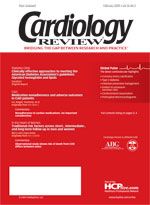Publication
Article
Cardiology Review® Online
New perspectives in cardiovascular medicine with emphasis on science, evidence, and treatment strategies: Highlights from the 19th Annual Scientific Sessions of the Association of Black Cardiologists
The 19th Annual Scientific Sessions of the Association of Black Cardiologists convened on Saturday, March 11, 2006, at the Hyatt Regency Atlanta, preceding the American College of Cardiology’s (ACC) 55th Annual Scientific Sessions. This year’s symposium focused on new concepts, guidelines, and advances in cardiovascular medicine, and incorporating basic science, clinical, and public health aspects into caregiving.
The Changing Face of Cardiovascular Risk Assessment,
The sessions were cochaired by John M. Fontaine, MD, and Jennifer H. Mieres, MD, and began with the Dr Daniel D. Savage Memorial Lecture, which was presented by Scott Grundy, MD, PhD, Director, Center for Human Nutrition and Professor of Internal Medicine and Biochemistry at the University of Texas Southwestern Medical Center in Dallas, Tex. In his presentation, Dr Grundy observed that the current status of cardiovascular risk is a mixture of progress and problems—a 50% reduction in tobacco use and lower cholesterol levels in the older population have been offset by such regressions as an epidemic of obesity and a 20% increase in diabetes.
The program moved forward with a progressive pro/con discussion on the role of cardiac resynchronization therapy (CRT) in patients with heart failure. The protagonist’s viewpoint, described by David L. Hayes, MD, Division Chair, Cardiovascular Diseases and Professor of Medicine at the Mayo Clinic College of Medicine, detailed CRT as a new and effective therapeutic tool for certain patients with heart failure. He explained that a significant number of patients receiving CRT improve and that there was a consistent decrease in the rate of hospitalization. Conversely, Michael O. Sweeney, MD, who serves as the Director, Cardiac Pacing and Implantable Device Therapies at Brigham and Women’s Hospital, presented a different view of the use of CRT and showed how the differences in confidence intervals between CRT and control studies may overlap, which means that real differences may not exist. Even if differences do exist, according to Dr Sweeney, they may be too small to be clinically relevant on a population scale.
As the day progressed, faculty explored the management of cardiovascular risk centered on the metabolic syndrome, with attention to studies that included the black population. There was an overview on the diabetes epidemic by F. Xavier Pi-Sunyer, MD, MPH, which addressed obesity as a therapeutic target of diabetes and heart disease, the challenges and optimal treatments of hypertension even in the 18- to 30-year-old group, and shortfalls in cholesterol management of more than half of the at-risk population. Dr Pi-Sunyer is Chief of Endocrinology, Diabetes, and Nutrition and the Director, Obesity Research Center at St. Luke’s-Roosevelt Hospital, Professor of Applied Physiology at Columbia Teachers College, and Professor of Medicine at the College of Physicians and Surgeons in New York. Later, Kenneth A. Jamerson, MD, Medical Director for the Program for Multicultural Health and Professor of Internal Medicine at the University of Michigan’s Health System, went on to report the results from hypertension clinical trials as they relate to new treatment guidelines.
The session’s presenters also reviewed the 2005 ACC/American Heart Association (AHA) guidelines for staging heart failure and how this affects the management of heart failure. New data on the proper use of left ventricular assist devices, nesiritide, and cardiac resynchronization therapy were also highlighted to clarify which patients receive the most benefit.
Additionally, in light of the rapid advances in cardiovascular imaging, there was a session on atherosclerotic plaque imaging techniques, the use of single photon emission computed tomography imaging, and current ACC/American Society of Nuclear Cardiology (ASNC) guidelines for the indications of nuclear dianostic modalities. Finally, an overview was given of the management of atrial fibrillation that included the new ACC/AHA guidelines, pulmonary vein ablation, and a thorough case-based approach.
Overall, the scientific program was well-received by the audience, who offered thought-provoking questions and lively discussion on the topics presented throughout the day.






